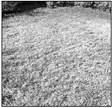Chinch bugs will return annually to sunny areas of your yard
Dear Neil: I saw your information on chinch bugs. I think that’s what we have. Should I treat now? What would we use?
This does look like chinch bug damage, but it’s probably too late to apply an insecticide for this season. You’ll need to replant in the worst of these spaces next spring, then be on the lookout for their presence next year. They’ll come back to the sunniest parts of your yard by early to midsummer. There are several good insecticides labelled for chinch bug control.
Dear Neil: We planted this oak in 1997. It has never had acorns on it until this year, and now it’s loaded. Is that unusual? Anything we need to know about?
Oaks, like pecans and other nut-bearing trees vary in how long it takes them to bear their first acorns, also in how large and frequent the acorn crops are. You may go several years before you see any more acorns. As long as the trunk and canopy of leaves look normal, there is no reason to worry.
Dear Neil: Our house was built three years ago. Bermuda sod was lazily dropped on top of clay soil. It has grown but remained pretty thin and sensitive to the heat. All I can think of is top-dressing it every spring and hoping that it will build up over the years. Do you have any better ideas?
Having a lawn with such a limited soil reservoir is similar to someone who has had gastric bypass surgery. More meals, but smaller portions. I’ve seen a demonstration of sod that was maintained on top of a concrete parking lot for 21 years – from the time a baby was born until she turned 21. It was a way of showing the effectiveness of one company’s fertilizer line. So, one fallback would be to water and fertilize more often, but with smaller amounts.
The other and probably better solution would be to rent a sod cutter to remove the existing turf. Set it aside temporarily while you bring in topsoil. Rake out the topsoil to a grade that will cause runoff to leave the property, then replant the grass and water it thoroughly.
Dear Neil: Attached are photos of our two rose plants. They both had new growth on them until recently. Now they look like they are dying. It has happened almost overnight. Can you tell what is going wrong?
I can guess, but nothing more. There isn’t enough plant tissue visible in the photos to give me the clues I need. My guesses would be that it could be rose rosette virus. It does attack young plants still in pots. Here is a link to my website where I leave detailed information archived since RRV has become such a problem. https://neilsperry.com/ notes/2018/04/rose-rosettevirus/ It could also be that the plants have been too wet for too long. They don’t look like they have grown very well this year, so soggy roots might have been an issue, or the plants may not have been very vigorous when you initially bought them. I wish I could give a better answer, but I just can’t tell.
Dear Neil: My wonderful old live oak tree has patches of brown leaves through its limbs. One entire branch is brown, and that limb hangs over our carport. How do I find a reliable tree care company that won’t take advantage of a senior lady?
Begin by looking for a “certified arborist.” That is a level of licensure that requires training and experience. The International Society of Arboriculture will help you find Certified and Master Certified Arborists in your vicinity. Go to their website and look for “Find a certified arborist.” https://www. treesaregood.org/findanarborist/ findanarborist).
Without a photo, I can only offer a couple of common causes. The extreme cold from February 2021 did cause many live oaks to lose bark and subsequently die back. Many of the trees that were so affected still have dead branches extending out from their canopies. Those branches can fall, as you suggested, and need to be removed as soon as possible. You will also see damage done by squirrels as they sharpen their teeth. They’ll riddle a branch by gnawing all the bark off. Parts of that branch will turn brown, but the leaves will hang in place. Those branches, too, will need to be removed.
Have a question you’d like Neil to consider? Email him at mailbag@sperrygardens.com. Neil regrets that he cannot reply to questions individually.




